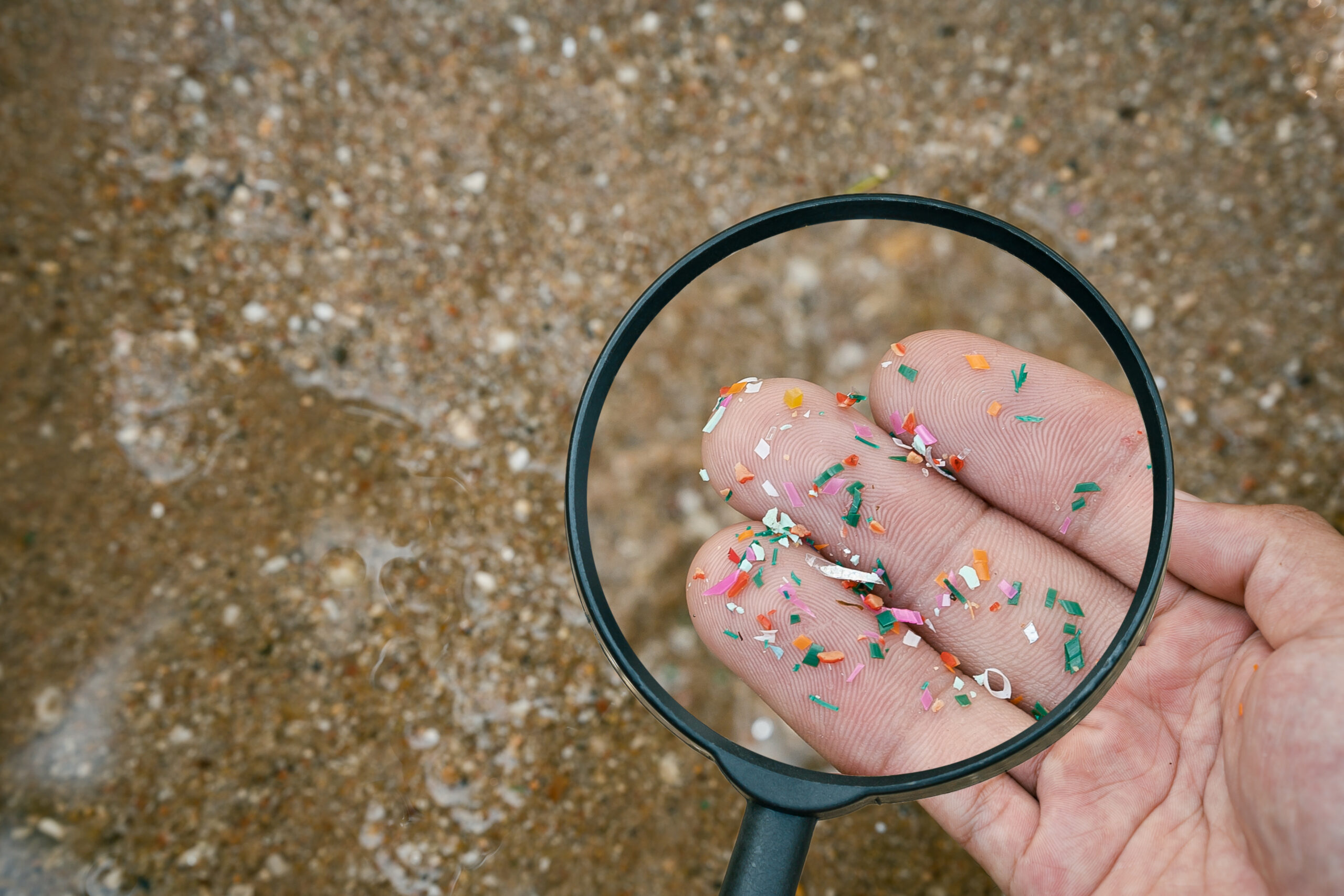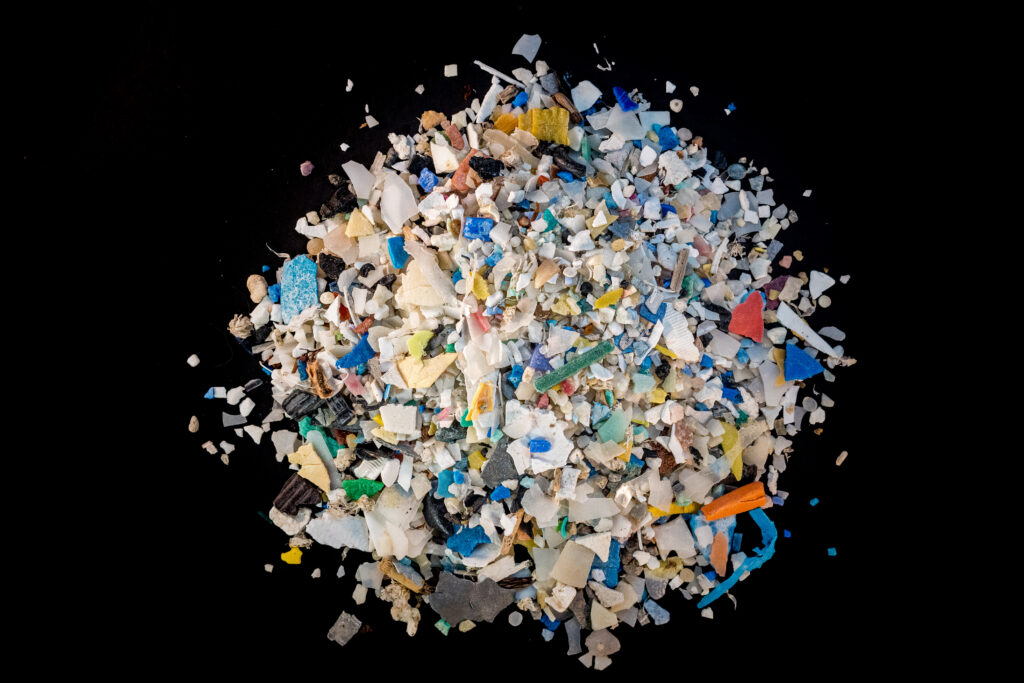
Plastic, Plastic, Everywhere
Plastic pollution globally taints land, air, and water. North Carolina is ramping up efforts to better understand and tackle the problem in aquatic ecosystems. Use the article from Coastwatch in your classroom.
North Carolina Standard Course of Study
6th grade science:
- 6.L.2 Understand the flow of energy through ecosystems and the responses of populations to the biotic and abiotic factors in their environment.
- 6.L.2.3 Summarize how the abiotic factors (such as temperature, water, sunlight, and soil quality) of biomes (freshwater, marine, forest, grasslands, desert, tundra) affect the ability of organisms to grow, survive, and/or create their own food through photosynthesis.
8th grade science:
- 8.E.1 Understand the hydrosphere and the impact of humans on local systems and the effects of the hydrosphere on humans.
- 8.E.1.4 Conclude that the good health of humans requires: monitoring the hydrosphere, water quality standards, methods of water treatment, maintaining safe water quality, and stewardship.
HS Biology:
- Bio.2.2 Understand the impact of human activities on the environment.
- Bio.2.2.1 Infer how human activities (including population growth, pollution, global warming, burning of fossil fuels, habitat destruction, and introduction of nonnative species) may impact the environment.
HS Earth/Environmental Science:
- EEn.2.4 Evaluate how humans use water.
- EEn.2.4.2 Evaluate human influences on water quality in North Carolina’s river basins, wetlands, and tidal environments.
- EEn.2.7 Explain how the lithosphere, hydrosphere, and atmosphere individually and collectively affect the biosphere.
- EEn.2.7.3 Explain how human activities impact the biosphere.
- EEn.2.8 Evaluate human behaviors in terms of how likely they are to ensure the ability to live sustainably on Earth.
- EEn.2.8.4 Evaluate the concept of “reduce, reuse, recycle” in terms of impact on natural resources.
Ocean Literacy Standards
- 1. The Earth has one big ocean with many features.
- 1.c. Throughout the ocean there is one interconnected circulation system powered by wind, tides, the force of Earth’s rotation (Coriolis effect), the sun and water density differences. The shape of ocean basins and adjacent land masses influence the path of circulation. This “global ocean conveyor belt” moves water throughout all of the ocean basins, transporting energy (heat), matter, and organisms around the ocean. Changes in ocean circulation have a large impact on the climate and cause changes in ecosystems.
- 1.g. The ocean is connected to major lakes, watersheds, and waterways because all major watersheds on Earth drain to the ocean. Rivers and streams transport nutrients, salts, sediments, and pollutants from watersheds to coastal estuaries and to the ocean.
- 6. The ocean and humans are inextricably interconnected.
- 6.d. Humans affect the ocean in a variety of ways. Laws, regulations, and resource management affect what is taken out and put into the ocean. Human development and activity leads to pollution (point source, non-point source, and noise pollution), changes to ocean chemistry (ocean acidification), and physical modifications (changes to beaches, shores, and rivers). In addition, humans have removed most of the large vertebrates from the ocean.
- 6.g. Everyone is responsible for caring for the ocean. The ocean sustains life on Earth and humans must live in ways that sustain the ocean. Individual and collective actions are needed to effectively manage ocean resources for all.
Guiding Questions
Use the article, as well as the resources below, to respond to the following guiding questions.
- Draw or describe three different pathways that plastic might travel from land to ocean.
- What are two ways that microplastics are formed?
- Why are scientists and others concerned about microplastics in the environment?
- Why is it important to document the amount of macro- and microplastics entering the Neuse River?
- Design a system to do one of the following tasks. Things to consider: power source, water depth, specific targets, disposal of plastics, etc.
a) Stop plastics from entering rivers and streams; b) stop plastics from entering the ocean directly; c) collect plastics from the ocean’s surface and water column. - Explain the phrase “reduce, reuse, recycle.” Then, add at least two more “r” solutions to the list, describing each addition.
- Why are oysters among the wildlife most susceptible to microplastic ingestion?
- Imagine that you are writing a marine debris action plan. Describe three approaches to preventing and/or removing marine debris that you would include in your plan.

Lesson Links and Resources
North Carolina Marine Debris Action Plan – Released in January 2020, this document represents a collaboration of many agencies and organizations and provides a framework for the prevention and removal of marine debris along the North Carolina coast.
NOAA’s Marine Debris Program – The Marine Debris Program was created in 2006 by the signing of the Marine Debris Act. This federal government office is the go-to group when it comes to any type of marine debris data and information. Discover details about all forms of marine pollution, learn about resources for educators, locate scientific papers about marine debris research, and subscribe to their blog.
My NASA Data – Ocean Circulation Patterns: Garbage Patches Story Map – Using various visualizations (e.g., images, charts, and graphs) and NASA data, students can explore the connection between ocean circulation patterns and ocean garbage patches. Students will also analyze regional plastic production and waste management data to describe how humans have contributed to ocean plastic pollution.
How Natural Disasters Contribute to Marine Debris – Explore the role that natural disasters, such as earthquakes, hurricanes, and floods, play in the marine debris problem around the world.
The Plastic Ocean Project – a nonprofit organization whose mission is to educate through field research, implement outreach initiatives, and incubate solutions to address the global program of plastic pollution. Learn about their “Ocean Friendly Establishment” designation and their traveling art exhibition created from plastic trash collected from local beaches.
Common Seas – Learn about this London-based organization that brings together researchers, policy experts, and behavior-change professionals to reduce the production of plastic waste and to keep that waste out of the ocean. The group coordinates four projects: Ocean Plastics Academy for educators (see below); Plastic Drawdown for governments; Clean Blue Alliance for plastic waste-free islands; and Healthy Me, Healthy Sea, about plastic and human health.
Debris Tracker Phone App – This community science app (for both iPhone and Android platforms) allows anyone to participate in a wide-ranging research project by taking and uploading photos of plastic debris found on beaches around the world. The app can be downloaded from the App Store or from Google Play.
Duke University Marine Laboratory Community Science Initiative – This DUML group connects 4th and 5th graders with marine debris research and local researchers by using community science and environmental literacy. The interdisciplinary activities fit into existing classroom studies.
5 Gyres Institute – Since 2009, this nonprofit organization has called attention to plastic trash in the ocean and in lakes and rivers around the world. Conducting research in all five ocean gyres, this group includes corporate executives, celebrities, and community scientists in their expeditions.
U.S. Environmental Protection Agency’s Trash Free Waters – Most of the trash found in our waters was mismanaged on land. EPA’s Trash Free Waters program focuses on reducing packaging and single-use plastics and preventing plastic trash from entering our waterways.
NOAA’s Resource Collection on Ocean Pollution – NOAA offers background information, as well as lessons and activities, focusing on marine debris and other aquatic pollutants.
Mitigating Microplastics: Teacher Lesson Plans – Oregon Sea Grant offers three lessons aimed at grades 6 to 8. Students will analyze both problems and solutions focusing on microplastics in the ocean. Although this series was designed as a one-week unit, the topic can be extended by adding a student project at the end of the lessons.
Marine Debris STEAMSS – This curriculum for grades 4-12 features more than STEM (science, technology, engineering, and math). The addition of art and social studies makes these activities more versatile. The teacher-created and pilot-tested lessons feature project-based learning (PBL) units and both classroom and field experiences.
Microplastics Awareness Project – Florida Sea Grant runs a citizen-science project with volunteers collecting coastal water samples, filtering them, and looking for microplastics — tiny bits of plastic that never biodegrade and are accidentally consumed by marine life, threatening their health, and possibly ours. The website contains a visual representation of the data collected through this project, as well as educational resources and a fact sheet about microplastics.
Plastic Free Milwaukee – This nonprofit organization based in Milwaukee, Wisconsin, is working to eliminate single-use plastics and keep the Great Lakes clean. Their compilation of original and borrowed activities and lessons targets all ages and grades.
Ocean Plastics Academy – an educational project of Common Seas, the Ocean Plastics Academy offers teaching guides, photo galleries, and infographics for educators, as well as home learning STEAM activities for ages 5-16. Their educational components are correlated with behavioral, cognitive, and socio-emotional learning objectives.
Science Friday: Engineering a Fix for the Great Pacific Garbage Patch — an activity for grades 6-8 in which students use the engineering design process to design a device that will capture suspended marine plastics in the marine environment while using natural forces to move through the water.
Turning the Tide on Trash – Originally produced by the U.S. Environmental Protection Agency and updated by NOAA’s Marine Debris Program, this interdisciplinary guide can be used with grades K-12. Individual lessons can supplement learning in other subjects.
Educators Guide to Marine Debris: Southeast and Gulf of Mexico – The teacher’s guide introduces the three main categories of marine debris — litter, lost fishing gear (commercial and recreational), and abandoned boats — and includes activities on stewardship and responsibility. This collection of lessons works well with grades 5-8.
Bridge Ocean Science Education Data Archive – a collection of activities developed by marine education specialists with Virginia Sea Grant based on research data. The data activities below correlate with this Coastwatch article and are appropriate for grades 8-12.
- Flotsam and Jetsam: A Little Litter Goes a Long Way – Using information from the International Coastal Cleanup, coordinated by the Ocean Conservancy, students will identify sources of marine debris and the impacts of this debris on wildlife.
- Ghostbusting in the Chesapeake: Rounding Up Derelict Fishing Gear – By analyzing data about abandoned or lost fishing gear and the animal species caught in that gear, students will explore the ecological impacts (positive and negative) of “ghost” gear in the Chesapeake Bay.
- Microplastics: It All Comes Out in the Wash – By now, most people are familiar with the dangers of straws, plastic bags and bottles, and other single-use plastics. But much smaller pieces of plastic that come from our clothing are a major source of pollution in our ocean.
Print Resources
- Abbing, Michiel Roscam. 2019. Plastic Soup: An Atlas of Ocean Pollution. Washington, DC: Island Press.
- Burns, Loree Griffin. 2007. Tracking Trash: Flotsam, Jetsam, and the Science of Ocean Motion. Boston: Houghton Mifflin Company.
- Ebbesmeyer, Curtis and Eric Scigliano. 2009. Flotsametrics and the Floating World: How One Man’s Obsession with Runaway Sneakers and Rubber Ducks Revolutionized Ocean Science. New York: HarperCollinsPublishers.
- Freinkel, Susan. 2011. Plastic: A Toxic Love Story. New York: Houghton Mifflin Harcourt.
- Hohn, Donovan. 2011. Moby-Duck: The True Story of 28,800 Bath Toys Lost at Sea and of the Beachcombers, Oceanographers, Environmentalists, and Fools, Including the Author, Who Went in Search of Them. New York: Viking Penguin.
- Moore, Charles and Cassandra Phillips. 2011. Plastic Ocean: How a Sea Captain’s Chance Discovery Launched a Determined Quest to Save the Oceans. New York: Avery.
- Siegle, Lucy. 2018. Turning the Tide on Plastic: How Humanity (and You) Can Make Our Globe Clean Again. London: Trapeze.
